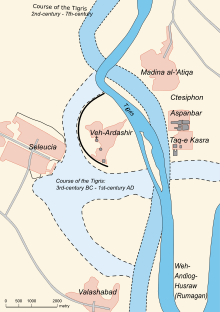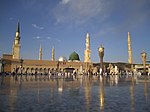Al-Mada'in
33°06′N 44°35′E / 33.100°N 44.583°E
Al-Mada'in (
Foundation and constitution
According to
Sasanian period

According to Perso-Arabic sources, Ctesiphon, the capital of the Sasanian Empire, was greatly enlarged and flourished during their rule, thus turning into a metropolis, which was known by in Arabic as al-Mada'in, and in Aramaic as Mahoza.[3] The oldest inhabited places of al-Mada'in was on its eastern side, which in Arabic sources is called "the Old City", where the residence of the Sasanians, known as the White Palace, was located. The southern side of al-Mada'in was known as Aspanbar, which was known by its prominent halls, riches, games, stables, and baths.[3]
The western side was known as Veh-Ardashir (meaning "the good city of Ardashir" in
In 495, during the turbulent reign of Emperor Kavad I, Mahoza (as the Jews called the city) was the scene of a Jewish revolt led by Exilarch Mar-Zutra II. After the king denied Jews the right to organize their own militia, Mar-Zutra took advantage of the confusion into which Mazdak's communistic attempts had plunged Persia and led a successful military revolt that achieved political independence for the Jews of Mahoza. The Jewish state lasted seven years until 502 CE, when Kavad finally defeated Mar-Zutra and punished him with crucifixion on the bridge of Mahoza.[4]
In 540, Khosrow I (r. 531–579) resettled captives from Antioch to the south of Aspanbur, a place which became known as Weh Antiok Khosrow, a Middle Persian name meaning "better than Antioch, Khosrow built this". It was known by the locals of the place as Rumagan ("town of the Romans"), while the Arabs knew it as al-Rumiya[3] (also spelled Rumiya).
In 590, a member of the
In 629, al-Mada'in was briefly under the control of Mihranid usurper Shahrbaraz, but the latter was shortly assassinated by the supporters of Khosrau II's daughter, the banbishn Boran. Al-Mada'in then continued to be involved in constant fighting between two factions of the Sasanian Empire, the Pahlav (Parthian) faction under the House of Ispahbudhan and the Parsig (Persian) faction under Piruz Khosrow.
Rashidun and Umayyad period
In 636, the
The Muslim military officer
In 661, al-Mada'in was under control of the Umayyad Caliphate, which had put an end to the Rashidun Caliphate. A certain Simak ibn 'Ubayd al-'Absi served as the governor of the metropolis in 663, and another person named Ishaq ibn Mas'ud served as its governor in 685. The Azariqa, a faction of the Kharijites, attacked al-Mada'in in 687/8, and massacred its inhabitants. The city was then governed by Kardam ibn Martad ibn Najaba, and some time later by Yazid ibn al-Harith al-Shaybani. In 696, the Kharjite leader Shabib ibn Yazid al-Shaybani briefly occupied al-Mada'in.[3] In 697, Mutarrif ibn al-Mughira was made the governor of al-Mada'in, and later in 701, Hanzala ibn al-Warrad and Ibn 'Attab ibn Warqa' were appointed as the combined governors of the metropolis. Some time later, the governorship of al-Mada'in was abolished.[3]
Abbasid period

In 750, the Abbasid family captured al-Mada'in and the rest of Iraq, and declared themselves as the new caliphate. In 754, the Abbasid caliph al-Mansur briefly held his court at Rumiya (which was included in al-Mada'in). He also had his prominent military officer Abu Muslim killed at the same place. In 755, the White Palace of al-Mada'in was destroyed under the orders of al-Mansur, who wanted to create a new city, which would later get completed in 762, and would be known as Baghdad, and would become the new capital of the Abbasid Caliphate (although he ordered the White Palace to be restored, it remained in decay).[3] After the foundation of Baghdad, the decline of al-Mada'in became faster, and many of the inhabitants resettled in Baghdad, while the Church of the East patriarch and the exilarch were forced to move to the city. Nevertheless, the patriarch Timothy I founded a hospital at al-Mada'in in 790.[3]
During the Fourth Fitna (809–813) between Caliph al-Amin (r. 809–813), and his brother al-Ma'mun (r. 813–833), al-Mada'in was captured in 812 by al-Ma'mun's general Tahir ibn Husayn, who then marched towards Baghdad.[6] In 817, the people of Baghdad revolted, and proclaimed the Abbasid prince Ibrahim ibn al-Mahdi as their leader. The rebels also managed to capture Baghdad's surrounding regions, which included al-Mada'in. One year later, al-Mada'in was recaptured by al-Ma'mun's Persian officer al-Hasan ibn Sahl, and by the next year, Iraq was once again under the control of al-Ma'mun.[7]
During the Abbasid civil war (865–866), Abu'l-Saj Devdad, a relative of the Iranian prince Khaydhar ibn Kawus al-Afshin, was put charge in the defense of al-Mada'in in 865.[8] The Abbasid caliphs al-Mu'tadid (r. 892–902) and al-Muqtafi (r. 902–908) further ruined al-Mada'in by digging it up for building materials to construct the Taj Palace in Baghdad.[3] In August 942, a battle occurred at al-Mada'in between a combined Hamdanid-Turkish army and the Baridis, who both fought for the de facto rule over Iraq. The battle ended in a Baridi defeat.[9]
Buyid period
In 945, the Iranian
After the death of 'Adud al-Dawla in 983, he was succeeded by his son
Seljuq period and Abbasid insurgency
In 1055, the ruler of the
Mongol, Jalairid, Kara Koyunlu, Timurid, and Aq Qoyunlu period
This section is empty. You can help by adding to it. (July 2014) |
Safavid and Ottoman period
The tomb of Salman the Persian was restored during the reign of the Ottoman Sultan Murad IV (r. 1623-40) and was further restored in 1904-1905.[citation needed]
Population and religion
During the Sasanian period, population of al-Mada'in was heavily mixed, it included
During the early Islamic period, the population of al-Mada'in consisted of tribal Arab leaders from
However, during this period much of the population of al-Mada'in resettled in the cities of
Archeology

Al-Mada'in has received considerable interest from archaeologists since the 18th century; the most famous landmark there is the
Excavation sites and ancient suburbs include:
- Seleucia
- Ctesiphon (previously thought to have been Opis, whose exact location is not confirmed)
- Aspanbur (Also written Isbanir, Asbanabr, Aspanbar, Asfanur)
- Veh Ardashir(Also Bahurasir, Coche, Choche)
- Valashabad (Balashkert), founded by Vologases I
- al-Ma’aridh
- Tell al-Dhaba’I
- Tell Dhahab
- Umm an Sa’atir
The site partially overlaps with the modern town of Salman Pak.
See also
- Firuz Shapur
- Talmudic academies in Babylonia
References
- ^ Jastrow, Marcus. "מָחוֹזָא". Dictionary of the Targumim, Talmud Babli, Yerushalmi, and Midrashic Literature. Cf. The Martyrdom and History of Blessed Simeon Bar Sabba'e, col. 810-811
- ^ Kröger 1993, pp. 446–448.
- ^ a b c d e f g h i j k l m n o p q r s Morony 2009.
- ISBN 9783161506062. Retrieved 15 January 2014.
- ^ Shapur Shahbazi 2005.
- ^ Rekaya 1991, p. 333.
- ^ Rekaya 1991, pp. 335–336.
- ^ Madelung, "Banu Saj"
- ^ Amedroz & Margoliouth 1921, pp. 31–32.
- ^ a b Kennedy 2004, p. 224.
- ^ Kennedy 2004, p. 293.
Sources
- Neggaz, Nassima (2021). "al-Madāʾin". In Fleet, Kate; ISSN 1873-9830.
- Morony, Michael (2009). "MADĀʾEN". Encyclopaedia Iranica.
- Amedroz, Henry F.; Margoliouth, David S., eds. (1921). The Eclipse of the 'Abbasid Caliphate. Original Chronicles of the Fourth Islamic Century, Vol. V: The concluding portion of The Experiences of Nations by Miskawaihi, Vol. II: Reigns of Muttaqi, Mustakfi, Muti and Ta'i. Oxford: Basil Blackwell.
- Rekaya, M. (1991). "al-Maʾmūn". In ISBN 978-90-04-08112-3.
- ISBN 978-0-582-40525-7.
- Zarrinkub, Abd al-Husain (1975). "The Arab conquest of Iran and its aftermath". In ISBN 0-521-20093-8.
- ISBN 0-521-20093-8.
- Kröger, Jens (1993). "CTESIPHON". Encyclopaedia Iranica, Vol. IV, Fasc. 4. pp. 446–448.
- Shapur Shahbazi, A. (2005). "SASANIAN DYNASTY". Encyclopaedia Iranica, Online Edition. Retrieved 30 March 2014.
External links
- The Shahr (province) of Asuristan (extract from the Encyclopedia of Iran)



